
Chives, scientific name Allium schoenoprasum, is a species of flowering plant in the family Amaryllidaceae that produces edible leaves and flowers. Their close relatives include the common onions, garlic, shallot, leek, scallion, and Chinese onion.
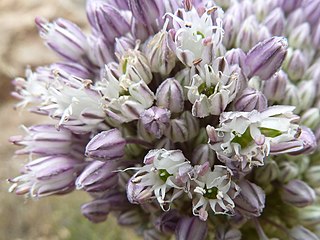
Allium ampeloprasum is a member of the onion genus Allium. The wild plant is commonly known as wild leek or broadleaf wild leek. Its native range is southern Europe to western Asia, but it is cultivated in many other places and has become naturalized in many countries.
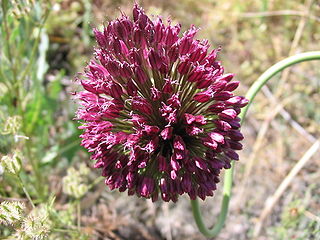
Allium sphaerocephalon is a plant species in the Amaryllis family known as round-headed leek and also round-headed garlic, ball-head onion, and other variations on these names. Other names include Drumsticks, and in Germany, Kugellauch. Some publications use the alternate spelling A. sphaerocephalum. It is a hardy perennial plant.

Allium nigrum, common name black garlic, broad-leaved leek, or broadleaf garlic, is a Middle Eastern species of wild onion. It lacks the onion or garlic scent shared by most of the other species in the group. The species is native to Turkey, Cyprus, Syria, Lebanon, and Israel but cultivated as an ornamental in many other places. It has become naturalized in some regions, including parts of the United States.

Allium caeruleum is an ornamental bulbous plant of the onion genus, native to Central Asia.

Allium moly, also known as yellow garlic, golden garlic and lily leek, Is a species of flowering plant in the genus Allium, which also includes the flowering and culinary onions and garlic. A bulbous herbaceous perennial from the Mediterranean, it is edible and also used as a medicinal and ornamental plant.

Allium siculum, known as honey garlic, Sicilian honey lily, Sicilian honey garlic, or Mediterranean bells, is a European and Turkish species of plants genus Allium. It is native to the regions around the Mediterranean and Black Seas, and grown in other regions as an ornamental and as a culinary herb.
Allium atrosanguineum an Asian species of onion native to China, Siberia, Mongolia, and Central Asia. It grows high in the mountains at elevations of 2400–5400 m.
Allium tschimganicum is a Central Asian species of onion native to Uzbekistan and Kyrgyzstan. The Flora of China regards this name as synonymous with Allium fetisowiiRegel. However, other sources accept A. tschimganicum as a distinct species.

Allium oreophilum, common name pink lily leek, is a plant species native to Xinjiang, Afghanistan, Kazakhstan, Kyrgyzstan, Pakistan, Tajikistan, Uzbekistan, Iran, Iraq, Turkmenistan, European Russia, Turkey, Azerbaijan, Armenia, Georgia
Allium platyspathum is an Asian species of wild onion. It has been reported from Xinjiang, Afghanistan, Kazakhstan, Kyrgyzstan, Mongolia, Altay Krai, Tajikistan, Uzbekistan, and Pakistan. It grows in damp locations at elevations of 1900–3700 m.

Allium carinatum, the keeled garlic or witch's garlic, is a perennial plant up to 60 cm tall. It is widespread across central and southern Europe, with some populations in Asiatic Turkey. It is cultivated in many places as an ornamental and also for its potently aromatic bulbs used as a food flavoring.
Allium decipiens is a Eurasian species of garlic in the amaryllis family native to eastern Europe and western Asia.

Allium flavum, the small yellow onion or yellow-flowered garlic, is a species of flowering plant in the genus Allium, which also includes the flowering and culinary onions and garlic. A bulbous herbaceous perennial, it is native to the lands surrounding the Mediterranean, Black, and Caspian Seas, from France + Morocco to Iran + Kazakhstan.

Allium pallens is a species of wild onion native to the Mediterranean region and Middle East from Portugal and Algeria to Iran.
Allium filidens is a species of onion found at high elevations of central and south-central Asia. It is a bulb-forming perennial up to 45 cm tall, forming a hemispherical umbel of flowers; tepals white or pink with a purple midvein.

Allium akaka is a species of onion native to Iran.
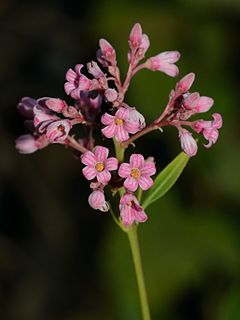
Apocynum venetum, commonly known as sword-leaf dogbane, is a plant species in the dogbane family, poisonous but used as a source of fiber, medicine, and nectar for production of honey. Apocynum venetum leaves have been used in the traditional medicine for hypertension treatment.
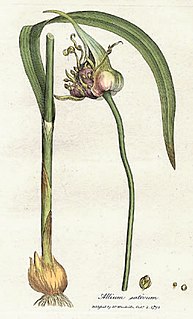
Allium is a genus of monocotyledonous flowering plants that includes hundreds of species, including the cultivated onion, garlic, scallion, shallot, leek, and chives. The generic name Allium is the Latin word for garlic, and the type species for the genus is Allium sativum which means "cultivated garlic".
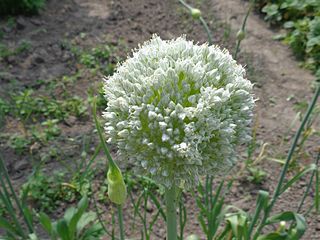
The precise taxonomy of the genus Allium is still poorly understood with incorrect descriptions being widespread. With over 850 species distributed over the Northern hemisphere Allium is the sole genus in the Allieae, one of four tribes of subfamily Allioideae (Amaryllidaceae). New species continue to be described and Allium is both highly variable and one of the largest monocotyledonous genera, but the precise taxonomy of Allium is poorly understood, with incorrect descriptions being widespread. The difficulties arise from the fact that the genus displays considerable polymorphism and has adapted to a wide variety of habitats. Furthermore, traditional classications had been based on homoplasious characteristics. However, the genus has been shown to be monophyletic, containing three major clades, although some proposed subgenera are not. Some progress is being made using molecular phylogenetic methods, and the internal transcribed spacer (ITS) region, including the 5.8S rDNA and the two spacers ITS1 and ITS2, is one of the more commonly used markers in the study of the differentiation of the Allium species.














